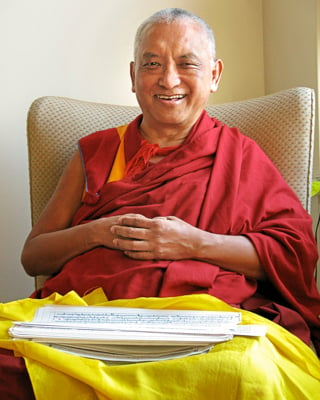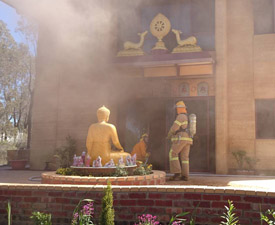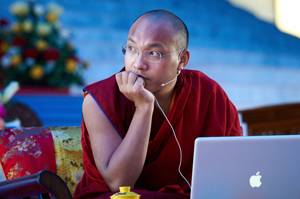Dear LYWA friends and supporters,
Thank you so much for your interest in and support of the LYWA. Together, we benefit so many sentient beings. Thank you.
I mentioned in last month's eletter that I was in Singapore and Malaysia. It was a wonderful trip and I was so happy to meet the many LYWA friends and supporters there. Thanks to all of you who looked after and fed me so well! I hope to be back again same time next year.
So, I got back to the LYWA home office Wednesday March 11 and the next day took a few minutes away from my computer to tidy up my office. I was placing a large portrait of His Holiness the Dalai Lama on a high shelf when the ladder slipped from under me and I crashed to the floor, landing on my left heel. The heel bone shattered and the force of the fall traveled up my leg and also snapped the neck of my femur. Next call, 911. The short story is that I've had a total hip replacement, which seems to have gone well, and I have a heavy cast-like boot on my foot and lower leg to allow the heel to heal. That will be there for two or three months. Oy vey!
 Well, I'm counting my blessings. It could have been worse, and Lama Zopa Rinpoche sent me a very kind note rejoicing at how much I purified. So I've got that going for me, which is nice! Also, my amazing wife, Wendy Cook, dropped everything to look after me day and night and I'm so grateful to her for her kindness. It would have been so much harder without her.
Well, I'm counting my blessings. It could have been worse, and Lama Zopa Rinpoche sent me a very kind note rejoicing at how much I purified. So I've got that going for me, which is nice! Also, my amazing wife, Wendy Cook, dropped everything to look after me day and night and I'm so grateful to her for her kindness. It would have been so much harder without her.
Lots of prayers and support from all over as well, so thank you dear friends, it's going to be fine. I'm out of rehab and back at work. This picture was taken when we stopped at the local supermarket on the way home. As you can see, I'm figuring out how to get around.
See below for latest news on some great books and new teachings on our website. Thank you.
AUDIO BOOK AND EBOOK NEWS
We are happy to announce that our forthcoming audio books are in production! Audible.com is producing four LYWA titles as audio books: His Holiness the Dalai Lama's Illuminating The Path, Lama Yeshe's Becoming Your Own Therapist, and Lama Zopa Rinpoche's How Things Exist and How to Practice Dharma. We are thrilled to be working with Audible on these audio books, and we are hoping the books will be ready in April or May.
 This month, LYWA brings you a new ebook, Dharma in Daily Life: Urban Meditation Skills by Ven Fedor Stracke, helping us bring the Dharma happily into our modern world. Ven Fedor has been teaching in FPMT centers since 1988 and most recently taught at Shantideva Buddhist Centre in New York City. Ven Fedor tells us:
This month, LYWA brings you a new ebook, Dharma in Daily Life: Urban Meditation Skills by Ven Fedor Stracke, helping us bring the Dharma happily into our modern world. Ven Fedor has been teaching in FPMT centers since 1988 and most recently taught at Shantideva Buddhist Centre in New York City. Ven Fedor tells us:
To be a happy meditator, it is important that over time the meditation becomes an antidote against disturbing thoughts, because only a lessening of disturbing thoughts can produce the inner happiness that one is looking for. The meditation needs to hit the spot.
You can download a free copy of Urban Meditation Skills here.
WATCH NEW VIDEO ON OUR YOUTUBE CHANNEL
Watch an informal teaching by Rinpoche while he is waiting for his flight in a Taiwan airport, where he answers the students’ question “How should we practice the Dharma?”:
And check out a great clip from Osel Hita sharing how he walks the Dharma talk with students at Losang Dragpa Centre in Malaysia. And in response to your requests we’ve added helpful subtitles to Rinpoche’s lightning-fast transmission of the Dancers of the Three Principal Aspects!
Watch for even more to come and be sure to subscribe to the LYWA channel to get immediate word when brand new video goes live!
NEW ADVICE ON OUR WEBSITE
 We have just posted a long advice from Rinpoche to a student who was battling depression, which includes specific practice advice. He encourages the student to rejoice:
We have just posted a long advice from Rinpoche to a student who was battling depression, which includes specific practice advice. He encourages the student to rejoice:
You met the Buddhadharma that shows the four noble truths and the path to achieve liberation from samsara. Not only that, you met the Paramitayana that shows the path to achieve enlightenment and to liberate the numberless sentient beings from the oceans of samsaric sufferings and bring them to full enlightenment. You met the Mahayana Tantra where you can achieve enlightenment in one life and even quicker—with Highest Yoga Tantra you can achieve enlightenment in one lifetime. It is the quickest way to free the numberless sentient beings from the oceans of samsaric sufferings and bring them to full enlightenment. Wow, wow, wow, wow. Amazing, amazing, amazing, amazing. So there’s no time for depression. Wow wow, wow, wow, wow!
Other advices posted this month include:
• Confession of Anger: A student wrote to confess a moment of anger toward Rinpoche that had arisen during a retreat 10 years ago and continued to feel disturbed by it.
• Unable to Prostrate: After having a knee operation a student was not allowed to kneel. She asked if she could recite the buddhas’ names and prostrate with her arms.
• Thanks for Offering Service at the Center: A student asked Rinpoche to be her guru and advised of her volunteer service at the center after meeting the Dharma.
There is also an excellent advice from Rinpoche with very clear and simple advice on how to offer waterbowls, which you can read below as our featured eletter teaching this month.
There are many more new advices added this month; see our website for a list of all new advices added in March.
A NEW EBOOK FROM VEN GYATSO AND NEWS ON THUBTEN SHEDRUP LING
LYWA is currently working on A Perfect Mirror, a new ebook offering reflections on truth and illusion from a western perspective by Ven Thubten Gyatso. Ven Gyatso was ordained by Lama Yeshe in the 1970s and is currently the director of Thubten Shedrup Ling Monastery in Victoria, Australia.
 You might have heard the monastery recently suffered a devastating fire which resulted in extensive damage to the gompa of their recently completed Abbot's residence. As explained on the Monastery website:
You might have heard the monastery recently suffered a devastating fire which resulted in extensive damage to the gompa of their recently completed Abbot's residence. As explained on the Monastery website:
The full extent of damage is yet to be determined but will be about $145,000. The spiritual loss is more difficult for the monks because most of the items were irreplaceable. A wooden Chenrezig statue from Mongolia of incalculable value has completely gone. A life size statue of Maitreya Buddha was also lost as well as many other items.
In response Ven Gyatso skillfully reflected “I thought there was no point in getting upset. The Buddhist teachings explain how everything is impermanent.” You can read more details in a story written in the local paper.
If you want to assist in their rebuilding efforts, please see the Thubten Shedrup Ling website.
DHARMA REPORTS FROM LYWA
 This month the US tour by His Holiness the 17th Karmapa began. His Holiness heads the 900-year-old Karma Kagyu school of Tibetan Buddhism, guiding millions of Buddhists around the world. At the age of fourteen, he made a dramatic escape from Tibet to India to be near His Holiness the Dalai Lama and his own lineage teachers. Currently twenty-nine years old, the Karmapa created an eco-monastic movement with over 55 monasteries across the Himalayas acting as centers of green activism.
This month the US tour by His Holiness the 17th Karmapa began. His Holiness heads the 900-year-old Karma Kagyu school of Tibetan Buddhism, guiding millions of Buddhists around the world. At the age of fourteen, he made a dramatic escape from Tibet to India to be near His Holiness the Dalai Lama and his own lineage teachers. Currently twenty-nine years old, the Karmapa created an eco-monastic movement with over 55 monasteries across the Himalayas acting as centers of green activism.
LYWA staff member Mer Stafford attended His Holiness' talk at Stanford University this month entitled "Caring Connections: Compassion, Technology and the Environment." Mer shares her experience with us:
His Holiness Karmapa showed such a powerful aspect in my opinion. The definition of compassion His Holiness used was "If we called compassion by another name or phrase, we could say that it's all about developing a sense of responsibility in relation to the reality of interdependence." His Holiness then went on to cite examples of the way our culture tends to not consider interdependence in relation to how our clothing and iPhones are made, how our choices impact the environment, etc. We need to take more social responsibility if we want to develop compassion. His Holiness came back to responsibility several times. I was sad that the talk ended so soon!
His Holiness is nearby this week giving a talk at Harvard University titled “Caring for Life on Earth in the Twenty-first Century”, and will then give many talks in the New York area through early April. See the tour website for details, and for links for tickets and live webcasts.
Thank you again for your kindness and support.
Much love, 
Nick Ribush
Director
THIS MONTH'S TEACHING: HOW TO MAKE WATERBOWL OFFERINGS
 In order to make waterbowl offerings, first generate a motivation of bodhicitta with the thought, "I'm going to make these waterbowl offerings in order to achieve enlightenment for the benefit of all sentient beings."
In order to make waterbowl offerings, first generate a motivation of bodhicitta with the thought, "I'm going to make these waterbowl offerings in order to achieve enlightenment for the benefit of all sentient beings."
When you clean the bowls, just as when you clean the meditation room in the preparatory practice of Jorchö, you can think that you are cleaning away the two obscurations of yourself and of all sentient beings. Think of whatever you are using to clean the bowls as the method and wisdom of the whole path to enlightenment, with which you are cleaning away the two obscurations. Relate the image to whichever meditation you are training in. For example, if you are meditating on impermanence and death, think that you are cleaning away the conception of permanence. If you are meditating on abandoning the eight worldly dharmas, think that you are cleaning away these wrong conceptions to which you are clinging.
You pile the bowls one on top of the other, then recite OM AH HUM three times as you fill the top bowl with water. During a Jorchö commentary, His Holiness Tsenshap Serkong Rinpoche explained that because you cannot set empty bowls on the altar, so then you pour most of the water from the top bowl into the next bowl, then set the top bowl on the altar. You then pour most of the water from the second bowl into the third bowl and place the second bowl on the altar.
The lamrim teachings mention that you should not place the bowls too far apart as this makes you distant from your gurus. And placing the bowls so that they touch each other becomes a condition to have a dull mind. You should leave a little space between the bowls.
The bowls should be beautifully arranged, without crookedness. The main point is that you should make the offering without cunning or deceit. The best offering is one made with a mind unstained by the eight worldly dharmas.
Once the bowls are lined up, you fill them with water. When you offer the water, start with a small stream, then a large stream, then finish with a small stream again. His Holiness Zong Rinpoche said that this helps to reduce the noise that you make. Since making a lot of noise creates a disturbed or unstable mind, it is good to offer the water as quietly as possible.
When you pour the water into the bowls, you should not overfill them, because if the water spills out, it becomes a condition for the degeneration of pure morality. According to the instructions of the lineage lamas of lamrim, you should leave a small space the size of a grain below the rim of the bowl. Some of the bowls made in India and Nepal have a line around the top to mark the water level.
While you are offering the water, you can recite the mantra of blessing that causes all the buddhas to receive clouds of offerings: OM NAMO BHAGAVATE... *
While you are offering, you can think like this to create more merit. On your altar are many pictures or statues of buddhas, and whether you are offering one waterbowl or many, in their view you are offering nectar. The most important point is to think that all the many representations of Buddha on your altar are embodiments of all your gurus and you are offering to your gurus. Among the holy objects, the guru is the highest, most powerful object. You can also think that the guru is all the buddhas; the guru is the embodiment of all the objects of refuge, Buddha, Dharma, and Sangha. They generate infinite bliss in their holy minds. Even if you have only one altar with one statue of Buddha, by thinking that it is the guru and offering each bowl, you immediately accumulate so much merit.
When you have finished offering all the bowls, you should think that there are numberless offerings, that the whole of space is filled with nectar offerings. The more extensively you can think, the more merit you accumulate. Think that even a tiny drop of that nectar generates infinite bliss. The bliss that is generated cannot fit in the sky.
Besides thinking that the pictures and statues on your altar are the embodiments of all the gurus, Buddha, Dharma, and Sangha, you can even think of all the holy objects in the ten direction: all the statues, scriptures, and stupas. In essence, the absolute nature of this is also the absolute nature of all the holy objects in the ten directions. When you have finished offering to the actual living gurus, Buddha, and Sangha, you can again offer the nectar to all those in the ten directions and generate infinite bliss in their holy minds. You can again offer to all the holy objects in the ten directions. By thinking in these different ways and offering again and again, you accumulate unbelievable merit in that half-hour or in that few minutes.
After this, you dedicate the merit. His Holiness Tsenshap Serkong Rinpoche used to explain that first you completely dedicate the merit and all its good results of temporary and ultimate happiness up to enlightenment to each sentient being: each hell-being, preta being, animal being, human being, deva being. Just as with the giving practice in tong-len, you give everything to each sentient being. With this dedication you have again accumulated infinite merit. Rinpoche used to say, "May sentient beings receive and experience whatever merit and happiness I have accumulated. And may I receive and experience upon myself whatever sufferings sentient beings have." Dedicate in this way. And after that, you can dedicate to achieve enlightenment for the sake of all sentient beings.
It is important not to forget to dedicate for bodhicitta. Dedicating to generate bodhicitta is one of the practices of the five powers and a means of accumulating extensive merit. We can dedicate like this after finishing prostrations or any other of the preliminary practices.
You then tip out the water. After you have emptied the water from the bowls, you should not throw it on dirty ground or where it will be walked on. This applies generally to anything, such as flowers, offered on an altar. You should throw the water in a flower garden or somewhere clean. Remember that this is an offering to the Triple Gem and it has been taken by the Triple Gem.
*NOTE: You can find this mantra and read more about its benefits on our website here.
Excerpted from a teaching given by Lama Zopa Rinpoche at Tushita Meditation Centre, Dharamsala, India, on April 13, 2007. Edited by Ven. Ailsa Cameron. For more teachings on this topic see The Benefits of Making Offerings and Lama Zopa Rinpoche's Online Advice Book.





























